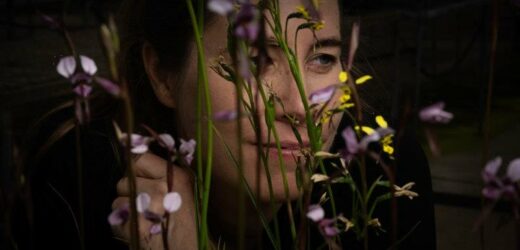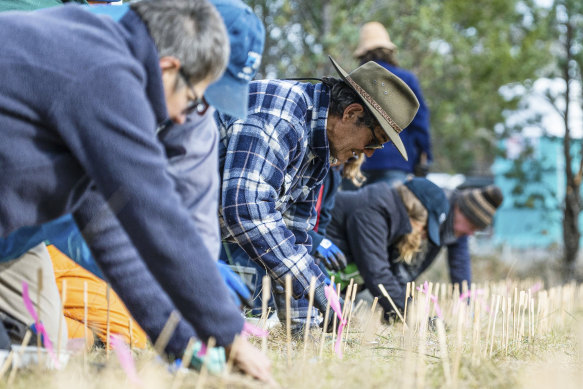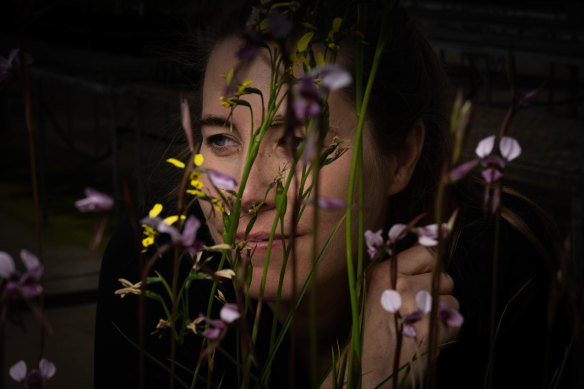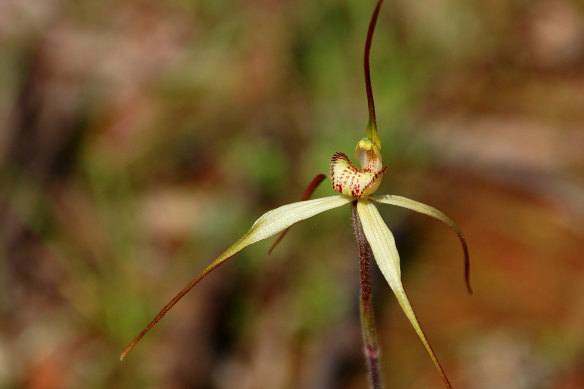Spending 10 days on your hands and knees in regional NSW planting more than 6000 native orchids isn’t for everyone. But for more than 40 volunteers, listening to the birds singing and swapping a few jokes helped during the long hours of trying to save the plant species from going extinct.
Three orchid species, the Crimson Spider Orchid, Sand-hill Spider Orchid and Oaklands Diuris, were transported more than 300 kilometres from Victoria before being planted in Albury and the NSW Riverina region by an army of 40 volunteers from the Australasian Native Orchid Society.
ANOS Victorian conservation officer Gary French said the project was initially daunting, but he was not one to shy away from a challenge. The mammoth task involved planting about 400 orchids a day, but the volunteers modified a few techniques to speed up the process.
Volunteers plant native orchids near Albury, NSW.Credit:Alex Pike/DPE
“By lunchtime on the 10th day, when the last plant was in the ground, it was a relief,” he said. “Planting orchids are not like planting a tree or shrub. You have to be careful in how you plant it. It’s not a matter of quickly putting it in the ground – it’s much more detailed.”
French said the sounds of nature and friendly banter with other volunteers helped him get through the long hours. But the project is far from over.
“Over the next three to five years, there will be some very detailed monitoring to keep tabs on the orchids to ensure they have survived and that there is pollination and seeding. Once you see that sort of thing and new plants are growing on the site, that is when you can tick it off.”
There are more than 800 species of orchids in Australia, with 17 per cent of these on the federal threatened plant species list, says Dr Karen Sommerville, a research scientist at the Royal Botanic Garden.
“Part of the problem has been land clearing, domestic stock grazing or trampling hard on the plants – they are hard to see unless they are flowering,” she said. “Other threats include weed invasions.”
Scientific technical officer Jess Wait says growing orchids is a difficult task, especially because they are so particular in their pollination and germination behaviours.Credit:Janie Barrett
Australian Botanic Garden scientific technical officer Jess Wait said since orchids are so particular in their germination and pollinating behaviours — with some relying on one insect species to pollinate them and a particular type of fungus to grow – if anything happens to disrupt these, their numbers can plummet.
“They are beautiful species and are highly complex. We appreciate them for the way they have evolved,” she said.
A Sand-hill Spider Orchid.Credit:M Cameron/DPE
NSW Environment Minister James Griffin said the government’s Saving our Species program found there were fewer than 2000 Sand-hill Spider Orchids, 1300 Oaklands Diuris and 650 Crimson Spider Orchids in the wild.
“This project gives us enormous hope for the survival of these rare and beautiful species because their populations have been boosted with 6000 additional healthy plants,” he said. “It’s a fantastic example of the great conservation outcomes we can achieve when we partner with private landholders and expert scientists.”
The project was done with the NSW Environmental Trust and Saving our Species program, the Department of Planning and Environment, National Parks and Wildlife Service, Royal Botanic Gardens Victoria and the Australian Network for Plant Conservation.
Get to the heart of what’s happening with climate change and the environment. Our fortnightly Environment newsletter brings you the news, the issues and the solutions. Sign up here.
Most Viewed in Environment
From our partners
Source: Read Full Article




